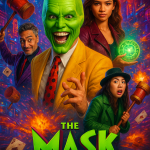Saint Seiya: Warriors of the Final Holy Battle (1989) – A Cosmic Clash of Myth and Might

Saint Seiya: Warriors of the Final Holy Battle (1989) – A Cosmic Clash of Myth and Might
Released on March 18, 1989, Saint Seiya: Warriors of the Final Holy Battle (originally titled Saint Seiya: Shinku no Shōnen Densetsu) is the fourth anime film in the beloved Saint Seiya franchise, a cornerstone of ‘80s shonen greatness. Directed by Masayuki Akehi and produced by Toei Animation, this 45-minute feature premiered as part of the Toei Manga Matsuri film festival, a celebration of anime that brought young fans flocking to theaters. Here, the Bronze Saints—those scrappy, cosmos-wielding warriors of Athena—face their most infernal foe yet: Lucifer, the fallen angel unleashed by the vengeful ghosts of defeated gods Eris, Abel, and Poseidon. With its fusion of mythological grandeur, Christian undertones, and relentless action, the movie hurls Pegasus Seiya and his comrades into a desperate holy war to save their goddess and the world from divine wrath. It’s a compact, high-stakes spectacle that captures the essence of Saint Seiya: dazzling battles, unshakable loyalty, and the triumph of hope against cosmic despair.
The Plot: A Fallen Angel’s Revenge
The story erupts with apocalyptic stakes. Lucifer, the ultimate symbol of rebellion and ruin, awakens from eons of slumber, his dark power surging thanks to the lingering malice of Eris (from Evil Goddess Eris), Abel (from Legend of Crimson Youth), and Poseidon (from the anime’s Poseidon Arc). These vanquished deities, still bitter from their defeats at the Saints’ hands, channel their fury into reviving the Prince of Darkness, giving him a singular mission: annihilate Athena and claim dominion over all gods, mortal and divine alike. His arrival at the Sanctuary—the sacred stronghold of Athena’s forces—is a brutal declaration of intent. The surviving Gold Saints, those radiant guardians clad in zodiac-inspired armor, step up to repel him, only to be swiftly cut down by Lucifer’s four Fallen Angels: Beelzebub, Astaroth, Eligor, and Moa. Their golden cosmos flicker and fade under the onslaught, leaving the Sanctuary a graveyard of shattered armor and broken dreams.
Athena, voiced with serene resolve by Keiko Han, refuses to let humanity pay for her battles. In a move both noble and reckless, she ventures alone to Fushima Hall—a haunting, gothic temple—to confront Lucifer, offering her life to spare the world his wrath. It’s a selfless gambit that strips her of her divine defenses, leaving her at the mercy of the fallen angel’s chilling schemes. Word of her peril races to the Bronze Saints: Pegasus Seiya (Tôru Furuya), Dragon Shiryu (Hirotaka Suzuoki), Cygnus Hyoga (Kōichi Hashimoto), and Andromeda Shun (Ryo Horikawa). These four—battle-worn but unbreakable—rally with their signature blend of grit and heart, charging into the fray to rescue their goddess. What follows is a climactic showdown, a “final holy battle” that pits their mortal cosmos against Lucifer’s infernal might, testing their courage, unity, and the very essence of their sainthood.
The Saints: Grit, Glory, and Gaps
The Bronze Saints are the beating heart of Warriors of the Final Holy Battl
each bringing their distinct flavor to the fight. Seiya, the fiery Pegasus, leads the charge with his unshakable determination, his Meteor Fist blazing like a supernova across the screen. Furuya’s voice crackles with passion, giving Seiya a raw edge that makes every punch feel personal. Shiryu, the stoic Dragon, channels his calm strength into devastating blows, his Rising Dragon a testament to his unyielding spirit. Hyoga’s icy cool shines through in his Diamond Dust, a shimmering counterpoint to the chaos, while Shun—gentle yet fierce—unleashes his Nebula Chain with a grace that belies its lethality. Their Cloths, those vibrant armors tied to the constellations, gleam with ’80s anime polish, their designs a love letter to the franchise’s mythological roots.
But not all Saints shine equally here. Shun’s fans might wince as he’s sidelined early, his chains snuffed out by a Fallen Angel in a blink-and-you’ll-miss-it defeat—perhaps a nod to his pacifist nature, though it stings for those who adore his quiet power. The Gold Saints, too, get short shrift; their cameos are fleeting, reduced to sacrificial lambs to hype Lucifer’s threat. It’s a narrative choice that prioritizes the Bronze crew but leaves a bittersweet taste for devotees of the broader Saint Seiya roster. Still, the focus on Seiya and his core team amplifies their underdog appeal—four mortals against a god, their cosmos flaring against impossible odds.
Visuals and Sound: A Mythic Feast
True to Saint Seiya tradition, the film dazzles with its signature aesthetic. The Cloths—Pegasus’s winged helm, Dragon’s emerald shield—burst with color and detail, their battle-worn scratches a badge of honor. The Fallen Angels, draped in dark, gothic designs, ooze menace; Beelzebub’s insectoid grace and Astaroth’s fiery elegance steal the screen, their attacks a blend of eerie beauty and raw power. Animation-wise, Toei leans on some recycled footage from the TV series—Seiya’s Meteor Fist looks familiar—but peppers in fresh, standout moments. The final clash, awash in light and shadow, feels like a cosmic fireworks show, with energy blasts tearing through the frame in a symphony of destruction.
Seiji Yokoyama’s score is the film’s secret weapon, elevating every scene with operatic grandeur. His orchestral swells—think booming brass and soaring strings—turn punches into heroic anthems and quiet pleas into soul-stirring cries. The soundtrack weaves Christian motifs into the mix, echoing Lucifer’s biblical roots with haunting chants that amplify the stakes. Paired with the voice cast’s fervor—Furuya’s defiant roars, Suzuoki’s steady resolve—it’s a sonic tapestry that lifts the film beyond mere action into mythic territory.
Pacing and Depth: A Double-Edged Sword
At just 45 minutes, Warriors of the Final Holy Battle moves like a comet—fast, fiery, and unyielding. The brevity keeps the adrenaline pumping; there’s no time to catch your breath as the Saints leap from crisis to combat. But that pace comes at a cost. Lucifer’s motivations—beyond a vague lust for power—remain thinly sketched, his dialogue leaning on ominous platitudes rather than depth. Why does he hate Athena so fiercely? What drives his alliance with the fallen gods? The film hints at cosmic vengeance but doesn’t linger long enough to flesh it out, leaving him a formidable but shallow foe.
The Gold Saints’ quick exits and the sidelining of supporting players like Ikki (Phoenix), who sits this one out, also trim the narrative fat—perhaps too much. Fans craving a sprawling epic might feel shortchanged, especially compared to the TV series’ sprawling arcs. Yet this lean approach plays to the film’s strength: unapologetic spectacle. It’s less about intricate lore and more about the visceral thrill of Seiya’s fist meeting Beelzebub’s claw, or Shiryu’s shield cracking under Eligor’s assault. The emotional core—Athena’s sacrifice, the Saints’ loyalty—carries the weight, grounding the chaos in something pure and timeless.
The Climax: Light vs. Darkness
The final battle is Saint Seiya at its bombastic best—a chaotic swirl of cosmos and carnage. The Bronze Saints, battered but unbowed, face Lucifer in a showdown that’s equal parts desperation and defiance. Their Cloths shatter, their bodies bleed, but their spirits blaze brighter with every hit. Seiya, as always, leads the charge, his Pegasus Ryu Sei Ken a beacon of hope against Lucifer’s shadowy abyss. The Fallen Angels fall one by one—each defeat a mini-triumph—until the devil himself takes center stage, his power dwarfing all that came before. It’s predictable, sure—good triumphs, evil crumbles—but the execution lands with fist-pumping satisfaction, a testament to the franchise’s knack for emotional payoffs.
Legacy and Appeal: ‘80s Anime Nostalgia
Warriors of the Final Holy Battle isn’t the deepest chapter in the Saint Seiya saga—its predecessor, Legend of Crimson Youth, digs further into character and myth—but it’s a fan favorite for its sheer bravado. Released at the tail end of the ‘80s anime boom, it embodies the era’s love for bold heroes, cosmic stakes, and unfiltered action. For Zodiac Knights devotees, it’s a nostalgic blast—a chance to see Seiya and crew in their prime, facing a foe ripped from Christian lore rather than the usual Greek pantheon. The film’s Christian slant—Lucifer, fallen angels—adds a fresh twist to the series’ mythology, broadening its scope without losing its soul.
Context and Impact
As part of the Toei Manga Matsuri, Warriors was a theatrical treat for kids and teens, a compact dose of Saint Seiya glory amid a lineup of anime shorts. Its 1989 release capped a prolific run of films that kept the franchise alive between TV seasons, cementing its status as a cultural juggernaut in Japan and beyond. While not as globally revered as Dragon Ball or Sailor Moon, Saint Seiya—and this film—found a fervent following in Europe and Latin America, where dubbed reruns turned the Saints into icons.
Final Verdict: A Holy Hit
Saint Seiya: Warriors of the Final Holy Battle isn’t a flawless epic—its brevity curbs its depth, and Lucifer’s menace lacks nuance—but it’s a dazzling showcase of what the franchise does best. With its bold visuals, mythic flair, and the Saints’ unbreakable spirit, it’s a 45-minute love letter to fans. For those who grew up cheering Seiya’s cosmos or dreaming of donning a Cloth, it’s a nostalgic jolt of ‘80s anime magic—perfectly imperfect, fiercely heartfelt, and gloriously over-the-top. Grab your armor and join the fight; the final holy war awaits.











